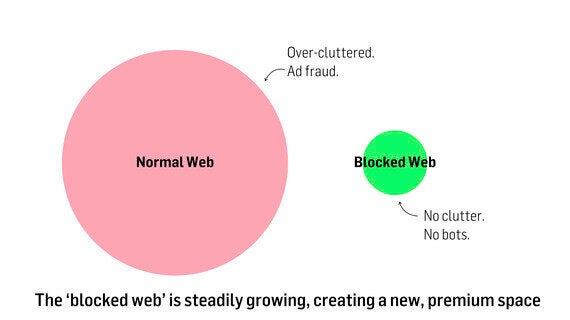Adblocking and publisher responses to it sit at the nexus of two trends: the increasing value of trust in the publisher-consumer relationship, and the emerging conditions of the new information market.
I wrote some years ago that the information market had been turned on its head. The Internet turns many types of information that were once scarce and expensive into overabundant - and therefore cheap - commodities. By corollary, trust and attention have become increasingly valuable.
In short: as information becomes cheap, trust becomes precious.
This generation suffers from the crushing pressure of information overload. Consumers trust premium publishers to help them cut through the white noise and present information and media that are worth spending their limited attention on. As the information deluge continues to swell over time this trust will become even more valuable.

We are witnessing the erosion of this trust and of the fair deal between users and content creators as millions of consumers install ad blockers. Publishers must choose between two conflicting options at this historic moment: to reinforce trust by addressing consumer grievances; or to ignore those grievances and restrict consumer choice.
This is a human question rather than a technological one. Adblocking will soon be technologically irrelevant. PageFair has the technology to serve ads in a manner that adblockers cannot circumvent, and some competitors claim similar abilities. Indeed, publishers can defeat adblocking by serving ads from their own editorial content systems. But the ability to serve ads should not prevent publishers from addressing the genuine consumer grievances that caused adblocking.
These consumer grievances that caused adblocking are now widely understood and can be summarised thus: aggressive ads obscure content, infringe on user privacy, hoover up bandwidth and thereby add expense to user's data plan and slow page load times, and expose users' devices to easily avoidable security hazards.
Ignoring these grievances and erecting an 'adblock wall' that prevents visitors from entering one's web site until they switch off their adblockers is a lost opportunity to rebuild trust with the user. In the longer term this tactic restricts user choice on the open web and harms publishers - with few exceptions - by causing large numbers of users to go to other sites.
The ultimate power to leave any website that does not live up to their expectations has always been in consumers' hands. It is a mistake to think of an adblock wall as a mechanism to give the a consumer choice rather than restrict their access.
The 'blocked web', the portion of the Web where users block ads, is steadily growing. This is creating a new, premium space that brand marketers - and therefore publishers - can ill-afford to ignore. Particularly since it is uncluttered and unaffected by ad fraud. But simply reinserting ads on the blocked web without addressing the consumers' grievances is a mistake that will undermine the trust between publisher and user.

Publishers must make sure that the technological solutions they employ to serve ads on the blocked web also solve the speed, privacy, and UX issues that caused adblocking in the first place.
It is worth describing the approach that we have taken at PageFair. Whether or not a publisher opts for PageFair or some other solution, the following are requisite elements in a sustainable response on the blocked web - irrespective of whatever one is doing on the normal web.
First, we decided to take a strong consumer-friendly approach on privacy. For example, our analytics respect the Do Not Track standard. Advertising can be relevant and at the same time be respectful of user's data.
Second, we adopted a robust approach to security. "Malvertising" incidents are only possible because hackers can programmatically book ads to deliver their malicious JavaScript into the user's browser. In programmatic and elsewhere we nullify this problem by executing active JavaScript in a safe sandbox on our servers, not in the user's browser.
Third, we learned how to limit the file size of ads to guarantee better page load times and protect the user from undue charges from their bandwidth provider. We also committed not to work with any ad formats that unexpectedly interrupt the main content of websites.
This is an approach built on the trust that users have the choice of what site to visit, and that publishers have the responsibility to protect users' data, bandwidth, security and experience.
This is not re-insertion, it is reinvention. Showing respectful ads in a way that protects consumers from hacking, data snooping, and unwanted data plan fees will start to re-establish trust on the blocked web.
Note: this piece first appeared at Digital Content Next.